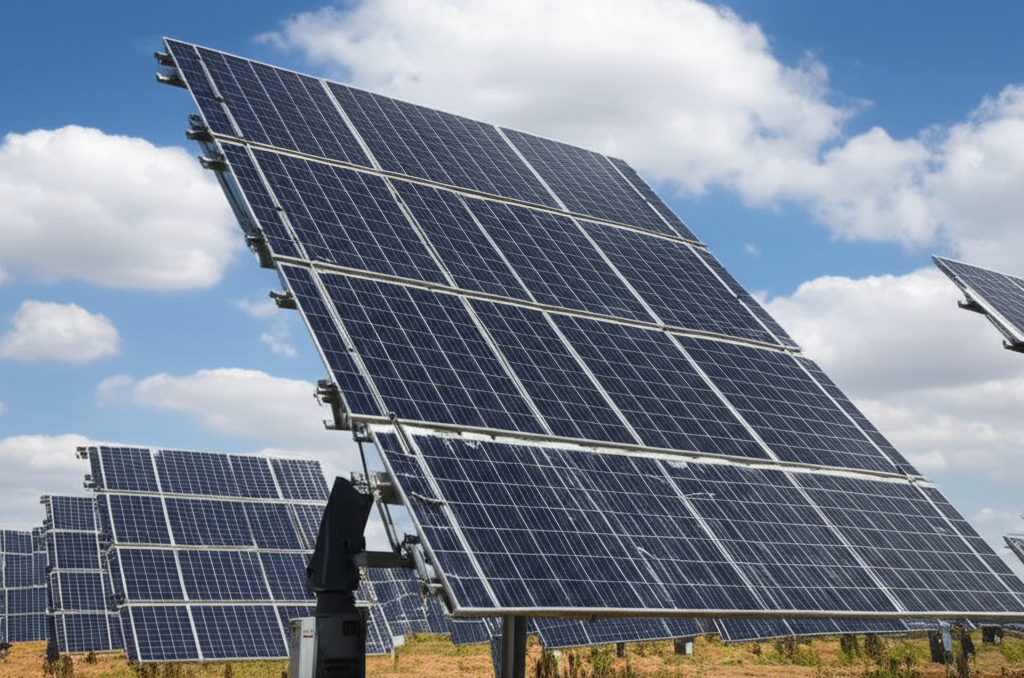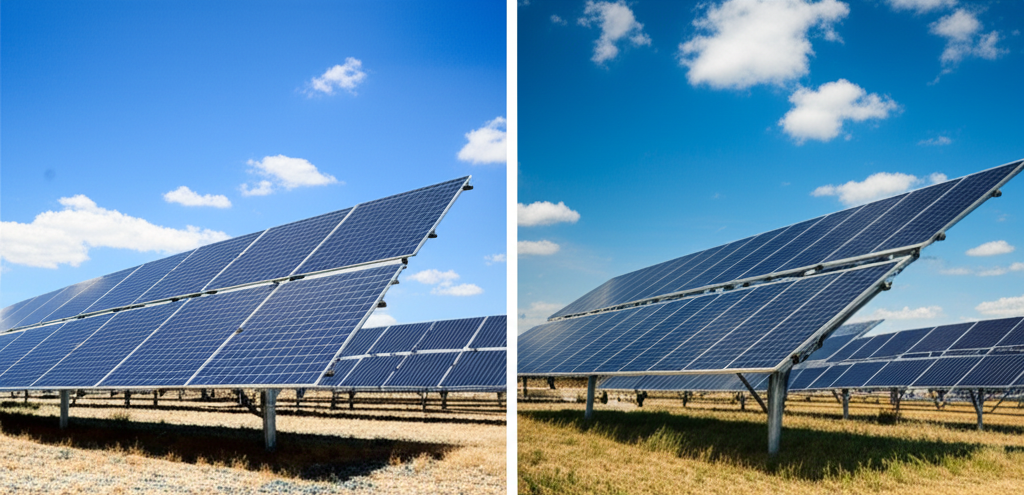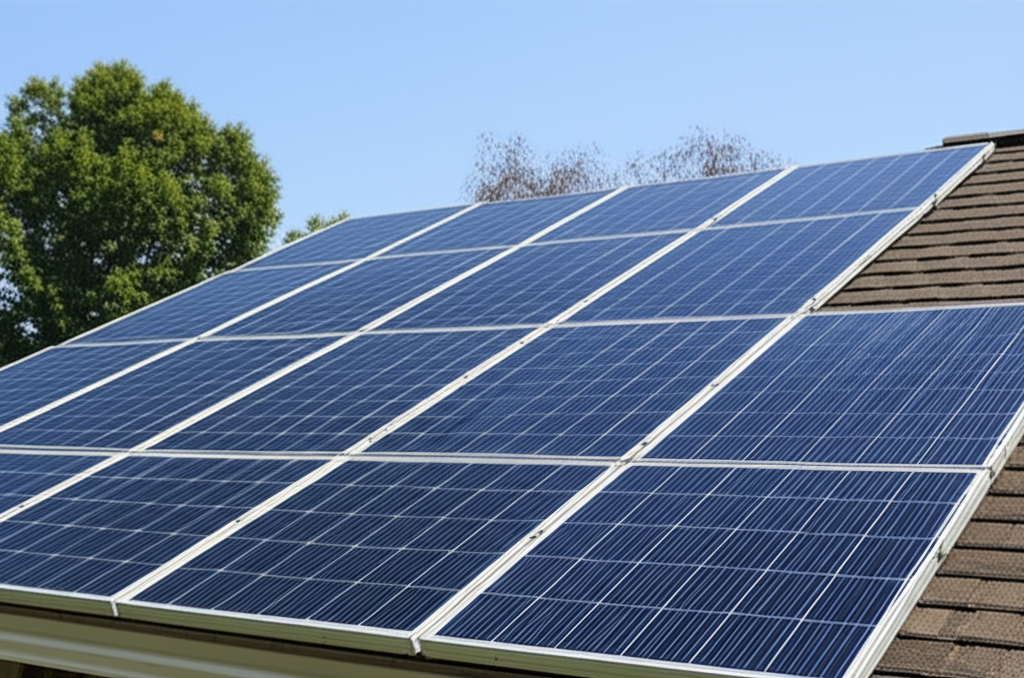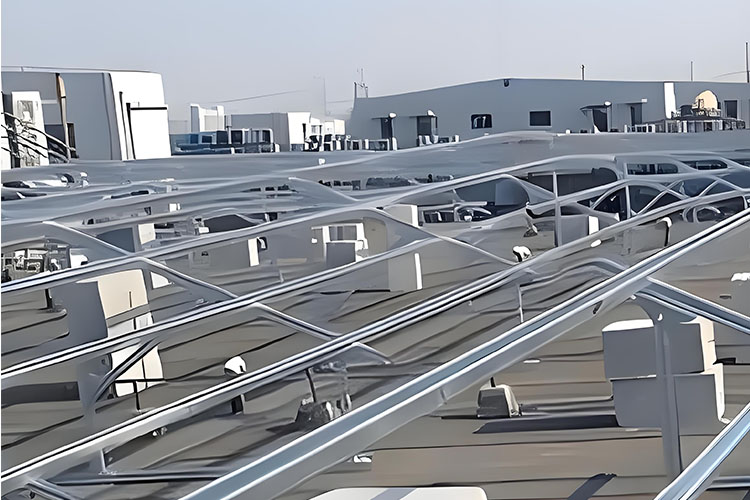Вы хотите получить прогнозируемую прибыль от использования солнечной энергии. Вам также нужно меньше разочарований при эксплуатации и обслуживании. Трекеры могут показаться еще одним подвижным компонентом. Они могут казаться опасными. Но это правда. Современные трекеры повышают выход энергии, снижают LCOE и сокращают время эксплуатации, если вы выбираете подходящую систему и управляете ею с самоконтролем.
Понимание солнечного трекинга: как это работает и почему это важно
Системы слежения за солнечными батареями направляют фотоэлектрические компоненты на солнце в течение дня. Одноосевые трекеры вращаются по одной оси. Двухосевые трекеры следят за азимутом и высотой. Контроллеры используют астрономические формулы и комментарии датчиков, чтобы позиционировать компоненты для оптимального облучения. Отличная система слежения уменьшает затенение, улучшает улавливание рассеянного света и обеспечивает защиту от ветра во время шторма.

Что это значит для отдачи? Независимые исследования показывают, что трекеры с одной осью обычно увеличивают энергию примерно на 15 - 25% по сравнению с отремонтированным наклоном. Двухосевые системы могут достигать 25 - 35% в зависимости от широты и расположения. При использовании трекеров с бифасиальными компонентами вы можете получить еще 5 - 15% от усиления задней стороны при соответствующем альбедо земли Дополнительные киловатт-часы на установленный ватт снижают LCOE в коммунальных задачах примерно на 5 - 10%, если место и дизайн оптимизированы.
SolPath от компании Jinwu Xuanhui Technology Co., Ltd. разрабатывает интеллектуальные системы слежения, которые позволяют достичь таких успехов. Вы получаете тенеустойчивое слежение, которое уменьшает затенение от ряда к ряду. Вы получаете возможность удаленного ввода в эксплуатацию и обновления по воздуху (OTA), что снижает цены на софт. Вы получаете контроллеры, приводы и размещение из единой цепочки поставок для более быстрой доставки и менее сложного освоения.
Миф 1: “Трекеры слишком дороги, чтобы оправдать окупаемость инвестиций”
Ускорение капитальных затрат вызывает чувство ужаса. Вы уважаете окупаемость. Однако окупаемость инвестиций зависит от срока службы и общей стоимости владения.
- Слежение по одной оси включает 15 - 25% мощности против наклона в нескольких местах - Двойная ось может обеспечить 25 - 35% при наилучших проблемах - Оптимизированное слежение сокращает LCOE на 5 - 10% в проектах масштаба коммунального хозяйства
Где это проявляется? Средние широты с высоким DNI. Места с благоприятными ветровыми и геотехническими условиями. Задачи, приносящие доход с каждого дополнительного кВт/ч по условиям PPA или на товарных рынках. Бифасиальные компоненты на трекерах могут улучшить усиление задней стороны для более мощной бизнес-экономики
Снимок ROI: Фиксированный и отслеживаемый (иллюстрация)
| Сценарий (100 МВт/c) | Прирост энергии по сравнению с фиксированным | Расчетная LCOE Дельта | Ориентировочное окно окупаемости |
|---|---|---|---|
| Базовая линия фиксированного наклона | — | — | — |
| Одноосевой трекер | +15–25% | -5-8% | 4-7 лет |
| Двухосевой трекер | +25–35% | -8-10% | 5-8 лет |
Цифры показывают разновидности рынка по независимым стандартам Ваш сайт определяет окончательные цифры.
Ценность SolPath обусловлена не только сталью и двигателями. Тенеустойчивые алгоритмы снижают потери от рассогласования. Удаленное назначение сокращает время монтажа. Обновления OTA позволяют повысить эффективность работы всего парка без переброски грузовиков. Это сочетание повышает доходность и снижает мягкие расходы, что уменьшает возврат средств.
Действенные шаги:

- Моделирование урожайности с использованием данных TMY для конкретного места и включение предположений о бифасиальной задней стороне.
- Уменьшение LCOE при разумной эксплуатации и дополнительных стратегиях.
- Убедитесь в том, что конструкция и ветровое ограждение соответствуют нормам района и расчетным значениям порывов.
Если контроль цен - ваш главный приоритет, изучите SolPath. Экономичный Трекер альтернативы для представленных реализаций.
Миф 2: “Трекеры часто ломаются и нуждаются в постоянном обслуживании”
Старые системы боролись. Современные трекеры этого не делают. Согласно рыночной информации, ежегодные расходы на обслуживание современных трекеров обычно не превышают 1% от первоначальных капитальных затрат, если использовать предиктивное обслуживание и интеллектуальные системы управления Integrity rises с менее сложными приводными механизмами, герметичными трансмиссиями и надежными контроллерами.
Трекеры SolPath используют замкнутый цикл комментариев и астрономическое позиционирование. Системы сохраняют устойчивость при сильном ветре, защищая строения. Режимы снегоочистки и защиты от тени улучшают доступность в суровом климате. Удаленный мониторинг быстро обнаруживает исключения. OTA-обновления прошивки предоставляют решения и атрибуты без работы на месте.
Профиль эксплуатации и управления: Фиксированный и отслеживаемый (типичные диапазоны)
| Тип системы | Годовая эксплуатация и обслуживание как % капитальных вложений | Ориентация на техническое обслуживание |
|---|---|---|
| Фиксированный Наклон | ~0,5-1,0% | Чистка и электрика модуля |
| Одноосевой | ~0,8-1,0% | Смазка, проверка привода, прошивка |
| Двухосевой | ~1.0-1.2% | Дополнительные проверки и калибровка соединений |
Разновидности показывают рыночные нормы и могут варьироваться в зависимости от сайта и техники
Лучшие методы, которые поддерживают высокий аптайм:
- Используйте смазку по состоянию, а не по расписанию.
- Проследите за токами двигателя и ошибками в размещении, чтобы выявить износ на ранней стадии.
- Каждый период проверяйте ветроукладку и лечебную серию.
- Стандартизируйте дополнительные комплекты для приводов и контроллеров.
Хотите получить структурированную стратегию обслуживания? Ознакомьтесь с программой SolPath Установка И Техническое Обслуживание поддержка списков и периодов.

Миф 3: “Треккинг едва ли улучшает энергетику, поэтому фиксированный - это нормально”
Отремонтированный наклон может хорошо послужить некоторым сайтам. В многочисленных областях слежение побеждает однозначно.
- Одиночная ось: +15 - 25% энергии против заботы о наклоне - Двойная ось: +25 - 35% энергии в сравнении с учетом наклона - Бифациальная + одноосевая: дополнительно +5 - 15% в зависимости от альбедо и расстояния между рядами
Местоположение имеет значение. Уменьшенные широты и чистое небо благоприятствуют слежению. В условиях рассеянного света контроллеры могут оптимизировать работу с рассеянным светом. Большое расстояние между рядами и устойчивое к тени слежение SolPath уменьшают затенение между рядами, поэтому вы собираете гораздо больше урожая ранним утром и в середине дня.
Прирост энергии по подходам (отраслевые эталоны)
| Подход | Прирост энергии в сравнении с фиксированным наклоном |
|---|---|
| Фиксированный Наклон | — |
| Слежение за одной осью | +15–25% |
| Двухосевое слежение | +25–35% |
| Одноосевой + бифасиальный | +20-40% общий против фиксированного (комбинированный) |
Данные, собранные из независимых записей Сайт проблем управления последними достижениями.
Если урожайность - ваша северная звезда, изучите SolPath. Умный Трекер Выбор, позволяющий точно настроить углы для рассеянного света и усиления заднего фронта.
Миф 4: “Трекеры предназначены только для крупных коммунальных проектов”
Коммунальные проекты лидируют по внедрению. Это правда. Небольшие по размеру приложения могут выиграть, если проблемы уместны.
- Коммерческие крыши со свободными пролетами и архитектурными возможностями.
- Наземные коммерческие объекты, расположенные за счетчиком, с тарифами по времени использования.
- Сельскохозяйственные и автономные системы, поощряющие дневной урожай.
SolPath предлагает масштабируемые стили для рассредоточенной генерации и особых нишевых применений. Взгляните на Коммерческий Трекер услуги, если ваш сайт имеет наземную часть. Откройте для себя Сельскохозяйственный Трекер для ранчо, которым требуется больше энергии в часы отдыха. Для обеспечения устойчивости удаленных сайтов рассмотрите следующие варианты Автономный Трекер.
Выбор по-прежнему зависит от пригодности участка. Вам нужны адекватные проблемы, низкое затенение, подходящая ветровая программа и экономичные конструкции. Если все эти пункты соблюдены, вы можете смело выходить за пределы коммунальных сетей.
Миф 5: “Трекеры не экологичны и являются источником отходов”
Трекеры добавляют сталь и средства управления. Кроме того, они увеличивают количество энергии на акр, что сокращает площадь земли в расчете на кВт/ч. Более высокая производительность снижает LCOE рабочих мест. Это снижение уменьшает выхлопы жизненного цикла в расчете на кВт/ч, поскольку производственное воздействие распределяется на большее количество поколений Бифасиальные компоненты повышают урожай с задней стороны без дополнительных активных компонентов
Компоновка SolPath обеспечивает долговечность и длительный срок службы. Контроллеры получают OTA-обновления, которые продлевают работоспособность без замены оборудования. Тенеустойчивое отслеживание сводит к минимуму неравенство, что помогает поддерживать работу модулей на более близком расстоянии друг от друга. Это означает более высокий уровень энергопотребления на протяжении десятилетий.
Если устойчивое развитие является главным для вашей программы, обратитесь к SolPath's Экологически Чистый Трекер подход к продуктам и рассуждениям о жизненном цикле.
Выбор правильной системы слежения за солнечными батареями
Ваш выбор определяет рентабельность инвестиций и риски. Начните с потребностей сайта и организации.
- Местоположение и широта определяют прирост мощности.
- Ветровые и снеговые нагрузки определяют архитектурную планировку и обоснование магазинов.
- Грунт и геотехнологии определяют стоимость конструкции.
- Работы по согласованию соединений и SCADA.
- Бифасиальный подход влияет на междурядья и обработку альбедо.
- Нацельтесь на отслеживание в тех местах, где широта и условия неба поднимают значимость возвращения.
- Сопряжение трекеров с бифасиальными компонентами для получения дополнительной энергии при соответствующих проблемах с грунтом.
- Очень осторожно разрабатывайте ветроукладку и проводите серию обследований для восстановления работоспособности.
- Используйте удаленный ввод в эксплуатацию и OTA-обновления, чтобы минимизировать временные затраты и повысить эффективность.
- Бюджет О&М на уровне или ниже 1% капитальных вложений с предиктивным обслуживанием и стандартными запчастями
- Работают ли солнечные трекеры в пасмурные дни.
- Сколько стоит солнечная трекерная система.
- Какова продолжительность жизни солнечного трекера.
- Можно ли добавить солнечный трекер к существующим солнечным панелям.
- Запросите оценку доходности и LCOE для конкретного объекта в сравнении с одноосевой установкой и двухосевой установкой.
- Проверьте геотехнические и ветровые проблемы до блокировки архитектурного проекта.
- Планируйте программу технического обслуживания и ремонта с учетом состояния и обновлений OTA с первого дня.
- Современные трекеры надежно работают в сложных погодных условиях благодаря настройкам защиты от ветра и снега. Удаленный мониторинг и OTA-модернизация снижают затраты на ручное вмешательство и техническое обслуживание. Усиление по двум осям может достигать 20-40% в благоприятных условиях, а по одной оси обычно составляет 15-30% на основании документации на изделие и отраслевых исследований. Системы SolPath обеспечивают интеллектуальное отслеживание в тени, удаленное назначение и полное покрытие цепочки поставок трекеров, контроллеров и креплений.
Быстрое сравнение: Одинарная и двойная ось
| Особенность | Одноосевой | Двухосевой |
|---|---|---|
| Прирост доходности по сравнению с Фиксированным | +15–25% | +25–35% |
| КАПИТАЛЬНЫЕ ЗАТРАТЫ | Более низкий | Более Высокий |
| Сложность ввода в эксплуатацию | Более низкий | Более Высокий |
| Лучшая посадка | Коммунальное хозяйство и крупные предприятия C&I | Специализированные сайты или ниши с высокой ценностью |
| Бифациальная Синергия | Сильный | Сильный |
SolPath обеспечивает сквозную доставку. Вы получаете трекеры, контроллеры и установку в одной программе. Решения совместимы с распространенными фотоэлектрическими модулями и инверторами. Контроллеры поддерживают удаленный ввод в эксплуатацию и OTA-модернизацию, что сокращает трудозатраты и ускоряет ввод в эксплуатацию. Для масштаба читайте о Отслеживание Масштаба Коммунальных услуг средства защиты. Для выбора на уровне компонентов изучите Компоненты Трекера.
Практические Советы на Вынос
Да. Контроллеры используют дорогостоящие алгоритмы для учета рассеянного света. Вы все равно выигрываете за счет того, что диапазон сохраняет оптимальный угол относительно рассеянного излучения.
Затраты зависят от места и выбора конструкции. Одноосевая система обычно требует небольших капитальных затрат по сравнению с отремонтированной наклонной системой, но при этом повышает энергопотребление на 15 - 25%, что часто снижает LCOE на 5 - 8% в задачах коммунального хозяйства.
Срок службы макета часто совпадает со сроком службы фотоэлектрических модулей, составляя 20-25 лет. Приводы и контроллеры следуют установленным циклам замены. Предиктивное обслуживание продлевает интервалы между заменами и сокращает время простоя.
Если позволяет конструкция и свободное пространство, можно переоборудовать систему для наземного монтажа. Ассимиляция с существующими инверторами и SCADA проста, если использовать общие пользовательские интерфейсы. Анализ участка позволяет проверить целесообразность и стоимость.

Следующие шаги
Все готово к тому, чтобы посмотреть, как трекинг изменит ваши показатели.
Откройте для себя SolPath Отслеживание Масштаба Коммунальных услуг расписание. Или начните с бюджетного пути через наш Экономичный Трекер. Если вам нужна беспроблемная установка и сокращение расходов в течение всего срока службы, обратитесь к Установка И Техническое Обслуживание.
Ссылки
Grand View Research. Размер, доля и тенденции рынка солнечных трекеров. Январь 2024.
Fraunhofer ISE. Существующие и будущие характеристики фотоэлектрических модулей и систем. Январь 2024 года.
BloombergNEF. Уравненная стоимость электроэнергии 2023.
Wood Mackenzie. Глобальный рынок солнечных фотоэлектрических трекеров, доли и поставки H1 2023.
NREL. Бифасиальные фотоэлектрические системы с отслеживанием: Повышенная энергоотдача. Апрель 2023 года.
Поверочные записки.